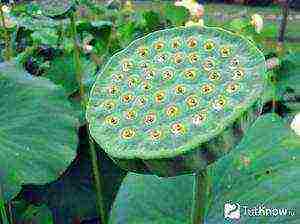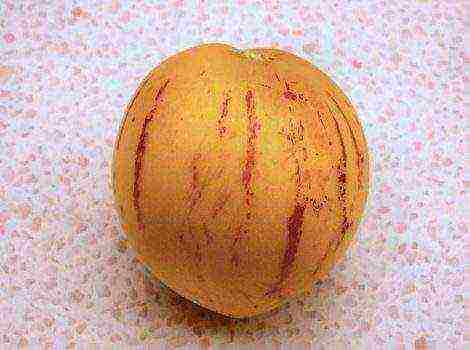Content
- 1 How to grow grapes at home
- 2 Growing features
- 3 Step-by-step technology for growing grape bushes from cuttings
- 4 Growing grape cuttings
- 5 Harvesting grape cuttings in autumn
- 6 Storage of planting material before planting in the ground
- 7 Germination of grape cuttings
- 8 Planting grape cuttings at home in cups or pots
- 9 Care of planted cuttings
- 10 Features of planting cuttings in the spring in a greenhouse or open ground
- 11 Features of cultivation in different regions
- 12 Reviews
- 13 What is a stalk (chubuk) of grapes
- 14 Procurement of planting material
- 15 Processing before storage (step by step)
- 16 Storing cuttings before planting
- 17 Timing of awakening (when do grape shanks start to sprout?)
- 18 Processing before rooting
- 19 What is grape pickling
- 20 Pre-germination of cuttings
- 21 Containers and soil
- 22 Landing in the ground
Grapes are a very thermophilic plant and we are used to growing them on huge plantations, mainly in southern countries. But over the past few decades, through the efforts of breeders, many hybrid varieties have been bred that can bear fruit in central Russia, and even closer to the north in closed greenhouses. At an average ripening temperature of + 18 ° C, you can get a harvest of juicy, fragrant berries in just 100-110 days. We will talk about the cultivation and cultivation of such grapes further.
How to grow grapes at home
Grapes are exactly the kind of culture that does not propagate by seeds, since in this case it does not retain its original genetic characteristics. It is not always possible to buy a ready-made seedling of a favorite variety. That is why the most accessible and widespread method of propagation of vines - cuttings.
Its availability lies in the fact that at home it is very easy to preserve, plant and root grape cuttings, prepare them for planting in open ground or a greenhouse. It is best to do this at home, since the rooting process should begin no later than late February - early March.
The most important thing is to choose a grape variety that is capable of good rooting.
Now, very many hybrid varieties have this ability, since cuttings are one of the main areas of work for breeders. Most often, gardeners like to plant table varieties on a garden plot with excellent taste, sugar content, large berries (preferably seedless), with early or mid-ripening periods.The varieties meet almost all these requirements: Delight, Kesha, Pleven, various varieties of Kishmish, Laura, Kodryanka, Anyuta, Aleshenkin, Veles and many others.
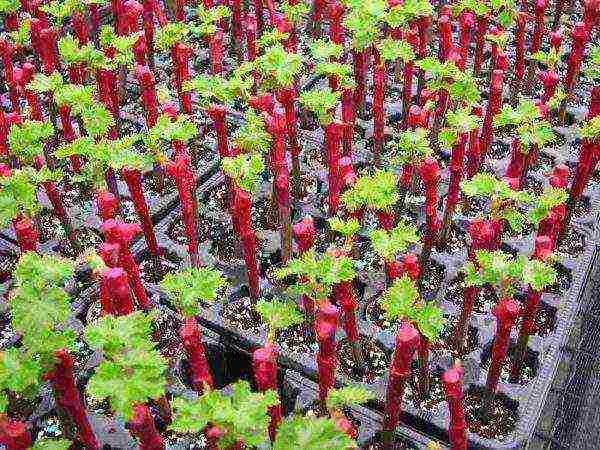 Before planting grapes in the ground, it is necessary to germinate the cuttings and wait for the first leaves to appear.
Before planting grapes in the ground, it is necessary to germinate the cuttings and wait for the first leaves to appear.
Growing features
Growing grapes in a greenhouse or in the open field directly depends on the natural climatic conditions of the region. It is clear that in the southern regions in the open field, grapes will have time to ripen not only early varieties, but also later ones. But in the Middle zone, the Moscow region and further to the north in open soils, only the harvest of the earliest varieties will ripen.
In regions where summers are short and winters are cold, it is best to grow vines in greenhouses in order to enjoy the taste of berries with different ripening periods for a longer time. But indoors, you will have to more carefully monitor the health of the bushes., microclimate, soil condition, since cases of fungal and other infections spread much faster. In an enclosed space, it is easier to prevent the occurrence of typical diseases than to eradicate them.
Step-by-step technology for growing grape bushes from cuttings
The whole process of obtaining rooted seedlings takes several months, but it is not very difficult in terms of labor intensity. Even novice gardeners who decide to take up viticulture are able to achieve the best results - this culture is so unpretentious, although it requires some attention. The main thing is to properly care for and carry out certain activities on time.
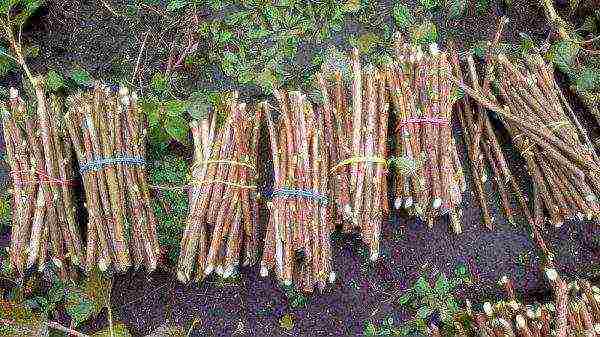 Chopped grape cuttings
Chopped grape cuttings
Cutting and storing shanks
The very first stage is the preparation of planting material. During the pruning of grapes in the fall, when all the branches bearing fruit this year are removed, cuttings are being prepared. It is the fruit branches that serve as the best material for future seedlings. What is necessary take into account:
- pruning is carried out after leaf fall, before the onset of the first frost;
- the vine should be as straight as possible, healthy, light brown or sandy in color;
- the longer the stalk, the better the reproduction will be.
The branch should be without visible damage, with a light bark, on the cut - green, with droplets of liquid (juice) protruding on it, the lower cut is made straight, and the upper cut oblique. Cutting length - at least 40-45 cm, cut diameter - 10-12 mm + 3-4 living buds with an interval of 10 cm between them.Sections should be made with a very sharp secateurs or a knife so that their tissues do not wrinkle, at a distance of at least 2 from the buds -3 cm.
Cut cuttings need to be prepared for storage:
- soak in cold water for 1-2 days, changing the water 2 times a day;
- process with a solution of vitriol or potassium permanganate (it is best to soak for half an hour);
- spread out on paper napkins (towels) and dry well from excess moisture;
- collect cuttings in a bunch, wrap tightly in plastic wrap, tie, fix a tag with the name of the variety (if there are grapes of several varieties, you need to store them in different bags, since different varieties have a bad effect on each other during storage); instead of film, you can use plastic bottles - lower the vine through the neck and close the lid.
Store the cuttings at t 0 + 5 ° C (a refrigerator, a glazed balcony, a basement will do).
 Cuttings can be stored both in the refrigerator and in the basement
Cuttings can be stored both in the refrigerator and in the basement
Preparation for rooting
In late February - early March, they begin to root the planting material. First you need to check how the material was preserved. To do this, the sections are updated, each at a distance of 0.5-2 cm from the upper and lower buds, respectively, in an oblique and direct way - they should be green and moist. Then the cuttings are immersed in water for 1-2 days (depending on the degree of dryness of the branches), to stimulate growth, it is necessary to add honey, aloe juice or humate (1 tablespoon / 10l of water).
At the lower heel, where the roots will grow, several grooves 2-3 mm deep and 2 cm long should be made with a needle - this will help to get a more developed, lush root system. The upper cut can be treated with paraffin.
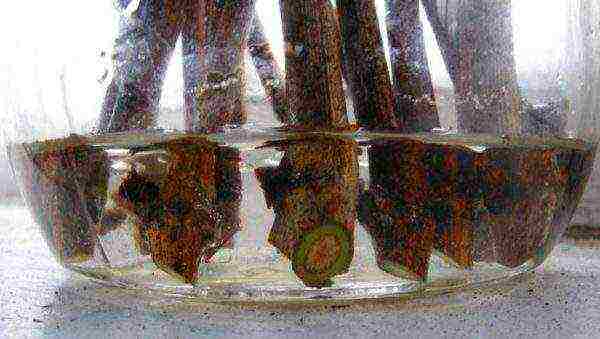 Checking cuttings for safety
Checking cuttings for safety
Germinating the cuttings in water
Put a layer of cotton wool about 2 cm on the bottom in an ordinary glass liter jar, pour the same amount of water (melted water is best), lower the cuttings. The heel - the bottom edge - should be in the water at a depth of 4-5 cm. To avoid decay of the liquid, you can put 2-3 tablets of activated carbon, add water periodically. On top of the jar, you can put on a plastic bag to create a greenhouse effect, put it on the windowsill.
Grapes, like any plant, need an abundance of light and warmth to grow vigorously. Twigs will appear first, and then roots. In order for the root system to develop, the shoots should be broken off; for a bush, one, the very last shoot will be enough.
Planting in pots in a greenhouse or greenhouse
The soil for the seedlings must be prepared in the fall by mixing equal amounts of turf soil, peat, sand, rotted manure or compost; ready-made mixture from the store is also suitable. As a container, you can use plastic bottles, larger disposable cups, etc., make drainage holes. A little drainage is poured at the bottom of the container, then the prepared soil, the cutting is carefully lowered onto it, poured with soil, slightly (!) Moistened.
The heel of the seedling should be at a depth of 1/3 of the container, and young shoots above the ground. Approximately until the end of May - beginning of June, young seedlings will have time to root well, develop full-fledged leaves and branches, and prepare for planting in the ground.
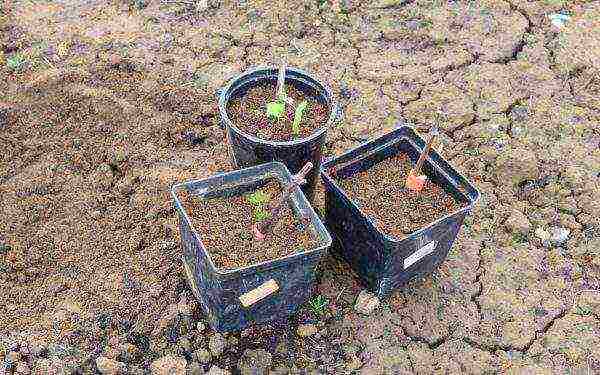 Planted shanks in pots
Planted shanks in pots
Rooting in sawdust or soil
In the southern regions, where in March the soil warms up to a temperature of 10-12 degrees at a depth of 10 cm, cuttings after processing and soaking can be planted directly into the ground - a school. Planting is done in prepared, well-fertilized soil to a depth of 40 cm. The cuttings are laid in pits (or a furrow), covered with earth up to half, tamped well, watered abundantly, pits are filled up to the top. 2 buds should remain on the surface of the earth. Focusing on the climate of the region, you can cover the surface or temporarily cover it with a film.
Another fairly common way to germinate cuttings is in sawdust.
The sawdust should only be of deciduous trees, without any admixture of harmful plywood or chipboard sawdust. They must be steamed before use - pour boiling water, then cool and in a deep dish (bucket) first pour a small layer on the bottom. Then, in an inclined state, lay out the sawdust in layers, placing the cuttings vertically between them. After planting, cover the dishes with foil, put them in a warm place and moisten the environment from time to time until sprouts and roots appear.
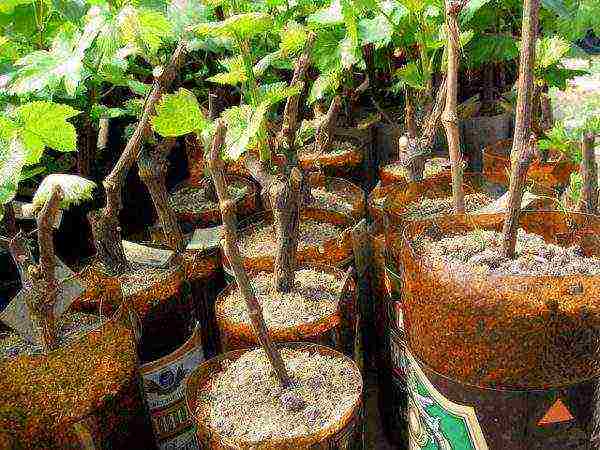 Rooting grapes in sawdust
Rooting grapes in sawdust
Correct planting of seedlings in open ground
The technology for planting in open ground is simple. The finished rooted seedling is first prepared for planting in open ground. To do this, within 5-7 days, seedlings in pots are taken out into the street, avoiding direct sunlight. After hardening, cuttings are lowered into the prepared holes along with an earthen lump, the holes are poured with earth mixed with humus, watered with warm water. The main thing is not to deepen the plant and water it moderately. In order not to damage the roots during planting, it is better to carefully cut plastic cups or other containers, then remove the seedling with an earthen clod.
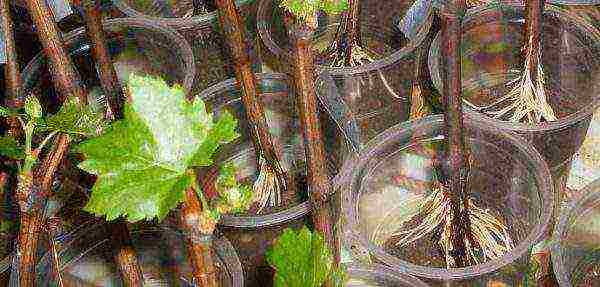 Rooted grapes ready to plant
Rooted grapes ready to plant
Be sure to immediately fix the support next to the grape seedling planted in the ground!
Germinating a grape stalk, rooting it and growing a seedling of your favorite crunchy sweet berry is not a lot of work.This can be done both in a polycarbonate greenhouse or greenhouse, and in the open field. Proper care for your pet - and he will thank you with active growth and a rich harvest, literally, in two or three years.
If a gardener has a desire to propagate grapes on his own plot, then he can use for this in two different ways. The first and easiest way is to buy seedlings in a special nursery. The second method, although labor-intensive, but more effective is the cultivation of grape cuttings in winter at home. The second method has several positive aspects that distinguish it favorably, namely, the gardener will be able to get grape seedlings of the desired variety, while such planting material is much more stable when compared with that acquired in the nursery. To grow high-quality cuttings on your own, you just need to put in a little effort.
Growing grape cuttings
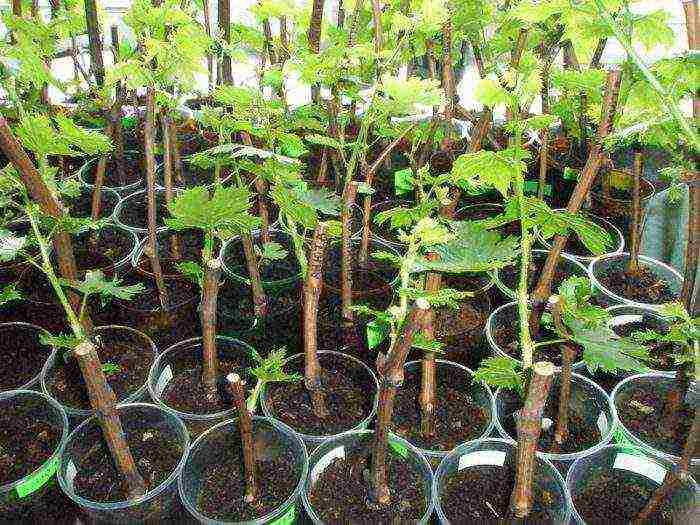
Before planting the cuttings in a permanent place, you must first prepare them. Most gardeners do not have the necessary experience in this matter, because rarely has anyone done this before. The process of preparing grape cuttings is divided into several stages, each of which is of great importance:
- slicing;
- storage;
- preparation for disembarkation;
- germination.
In order to succeed in this business, you need to know all the basic rules for growing grape cuttings, as well as tricks and secrets.
Stage 1: Cutting cuttings
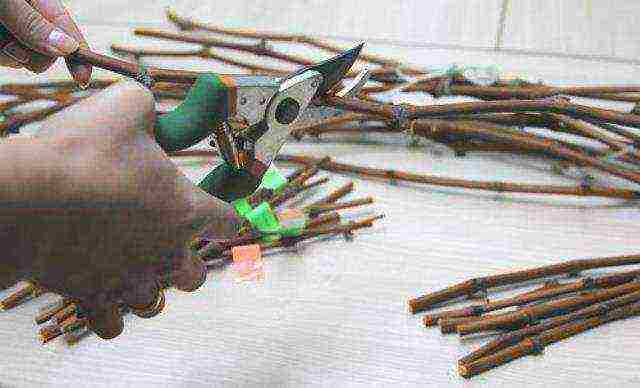
In autumn, all weakened or damaged branches die off, therefore it is at this time of the year that it is recommended to harvest grape cuttings (shanks). When cutting them, you must adhere to several basic rules:
- It is recommended to start cutting the shanks only when all the foliage has fallen from the bush.
- Try to select those branches that produce large clusters. The fact is that it is from such branches that the best planting material is obtained.
- Choose a vine that does not have curved shapes. It is best if it is as flat as possible.
- It should be remembered that the quality of the planting material is directly related to the length of the cutting.
Remember that cutting the shanks at sub-zero temperatures is by no means possible. In this regard, if there are already frosts outside the window, then cuttings can be made only next year. To cut the shanks, you need a pruner. Prepare a solution of copper sulfate and immerse the cuttings in it immediately after cutting them.
Stage 2: Storage
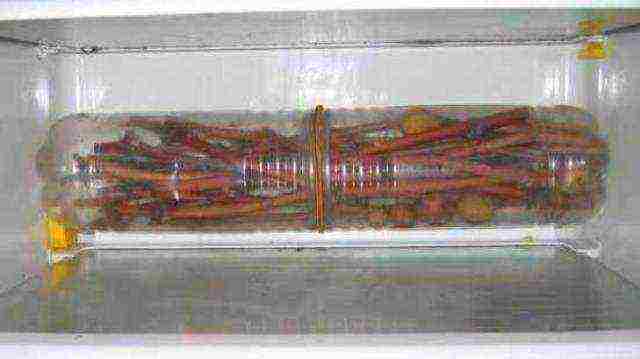
In order for the shanks to survive until spring, it is necessary to create the most favorable conditions for them. First of all, you need to divide the cuttings by grade. Then the cuttings of the same variety are tied together and placed in a separate polyethylene bag, which is then wrapped very tightly. It should be noted that you will have to save the grape shanks until spring. The fact is that it is at the beginning of the spring period that they are planted in open ground. There are several places where you can store grape cuttings quite successfully:
- Refrigerator shelf. This storage method is effective only when there are relatively few shanks.
- Basement. This storage method is ideal for those gardeners who grow grape seedlings not only for themselves, but also for sale.
- Country cottage area. There are also those gardeners who have learned to save material for planting until spring, simply by burying it in the ground. It should be remembered that the cuttings must be buried to a depth of at least half a meter.
In the process of storing the shanks in the winter, various problems can arise, in this regard, it is necessary to systematically inspect them. In the event that you notice that the buds on the stem began to swell, this means that there is a high temperature in the place of their storage.If this is a refrigerator, then you just need to lower the temperature, otherwise move the cutting to a place where it is colder.
Stage 3: Preparing for planting
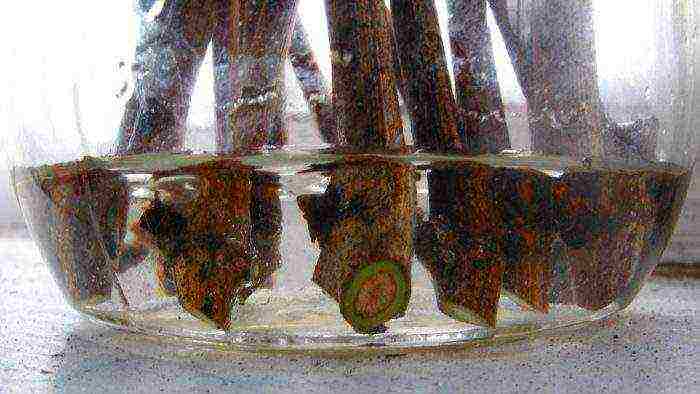
In the case when the grape shanks are well preserved, they can be quickly and easily prepared for planting in open soil. First of all, you will need to inspect each grape cuttings, while you need to remove those of them that are unsuitable for growing. To understand whether the shank is suitable for planting or not, you can make a transverse cut on it. Examine the incision site. In the event that it remains completely dry, then such a cutting can be thrown away, the fact is that it is completely dry and will not be able to give either roots or buds. In a good growable shank, moisture should come out of the cut. You also need to carefully examine the color of the cut. In the case when the stalk has spent the whole winter in favorable conditions for it, then its cut should be painted in a rich green color. Examine the cut carefully, as there should not be a variety of inclusions.
After you have thoroughly examined the grape shanks and graded them, you can begin the procedure that will wake them up. Take a container of the required volume and fill it with lukewarm water. Then dip the grape cuttings into it. They will have to stay in the water for at least two days. After that, prepare a solution of an agent that stimulates the growth of roots (you can buy it at a specialty store). When you take the shanks out of the water, they must be immediately immersed in this solution.
Stage 4: Germination

This stage is the very last and at the same time it is very important. In order to germinate cuttings, gardeners use two methods, so you can choose the one that is most suitable:
- With a glass. You need to prepare a large plastic glass. On the bottom, you need to make 3 large holes, it is most convenient to do this with an awl. Pour soil mixed with compost at the bottom. Then you need to take a glass of plastic with a smaller volume and cut the bottom out of it. After that, this glass must be inserted into the first glass with earth. A smaller glass should be filled with sand and water it well. The chubuk must be stuck in the sand. In order to keep warm there, it is recommended to use polyethylene film.
- With a plastic bottle. You will need the most common plastic bottle. A not very high drainage layer must be laid on its bottom. A layer of compost, nutrient soil or peat must be poured over it. A shank immersed in the soil should have the tip at the same level as the bottle. The bottle is covered with a plastic glass on top. After the formation of the first young shoots, the shelter is removed.
Both of these methods are quite effective. However, in order to successfully grow grape shanks, they need to provide systematic watering, as well as good lighting. It is possible to transplant cuttings into open ground only after they have formed roots and the first foliage has grown.
Rooting lignified cuttings is the main method of grape propagation, available even to a novice gardener. The principles of growing seedlings from cuttings vary slightly depending on the region and have many options, but the success of obtaining high-quality seedlings, subject to simple rules, is guaranteed. You just need to get some cuttings of the variety you like and be patient.
Harvesting grape cuttings in autumn
The time when it is already possible to cut grape cuttings in the fall for early spring or even winter planting for germination comes when the leaves begin to turn yellow. During this period, they can be cut off, and after a week, cuttings can be cut. However, you should not rush, because it is much more convenient to do this in late autumn, during the main pruning of bushes before sheltering for the winter.By that time, the leaves will be gone, the unripe vine fragments will freeze from the first mild frosts, and everything will be "in full view." Leaving the harvesting of cuttings in the spring is not worth it: who knows what will happen to the vine in winter?
Often the top of the vine does not have time to ripen during the summer period, and it must be removed. Actually, after the first frost it is perfectly visible. A well-ripened vine crackles when bent. It is advisable only to have time with the slicing before temperatures below -5 ° C. In the fall, cuttings should be cut longer than they are required for planting, with 5-6 buds, since in the spring they will again need to be cut on both sides. The best shoots for grafting are at least 5 mm in diameter, from the middle of a vine that has grown to at least one and a half meters in length. Thin cuttings will also take root, but the process will go slower, the seedlings will not grow so strong.

After leaf fall, choosing the desired section of the vine is simple, everything is clearly visible
If this first and simple operation is not performed correctly, further work may be useless. The most common errors are:
- cutting too thin cuttings;
- cuttings are not taken from the middle of the vine: it is the areas from the middle of the shoot that are better stored, they have the most developed buds;
- cutting was done early: the vine ripens until the very frost, and there is no need to rush with this procedure.
Storage of planting material before planting in the ground
To preserve the cuttings until winter, you need a cellar or shelf in your home refrigerator. They will have to lie there until about mid-February, the optimum temperature is about +1 oC.
Before sending to the cellar, the cuttings must be prepared. This will require:
- Treat with a chemical to destroy possible disease spores: you can use iron or copper sulfate (1% solution) or Chinosol (0.5%), soaking for a couple of hours.
- Soak for 1-2 days in water, so that they do not dry out too much during storage.
- Air dry until clear drops are removed (you can simply wipe off with a cloth).
- Put in a plastic bag, leaving only the tops of a few centimeters long outside, and tie.
- Do not forget to sign the package.
If possible, not "naked" cuttings are put into the bag. It is useful to overlay them with pine or spruce sawdust, but first the sawdust must be scalded with boiling water. Coniferous resin has a beneficial effect on the safety of cuttings, protecting them from accidental mold. During the winter, the sawdust should be changed once or twice. At the same time, carefully examine the cuttings for their suitability, throwing out the clearly blackened ones.

Before sending for storage, labels must be made indicating the variety and origin of the cuttings.
The maximum possible storage temperature for cuttings is 6–7 ° C. Air humidity should be slightly less than 100%. Periodically, a revision of the planting material is required: if even traces of mold are found, the cuttings must be wiped off and washed with a pink solution of potassium permanganate. If drying is found, soak for several hours (if necessary - up to a day) in water and send it back to the cold.
Germination of grape cuttings
In most regions of our country, work with cuttings put in storage in the fall begins at the end of winter. First, they need to be prepared for later life, it will be difficult in any case. To begin with, cuttings you need:
- Unpack.
- Wash in a dark solution of potassium permanganate.
- Rinse with clean water.
- Dry slightly.
Perhaps not everyone survived the winter well, so you need to check their survivability. If you lightly scrape off the bark of a live cutting, green tissue should appear underneath. A brown, yellow or black color suggests that such a cutting will have to be thrown away.
Now from the long stocked cuttings it is necessary to cut those that we will plant. Short cuttings for planting should have three healthy buds (two are possible, if they are well developed, then that's enough). Cuttings of grapes with three developed buds are traditionally called shanks. Cuttings with a large number of buds will give many roots, which is not very convenient when growing at home.
The upper cut should be straight and 2–3 cm above the kidney, the lower one (1–2 cm under the kidney) is made obliquely.
In any case, the prepared cuttings should swim in the water for 2-3 days (preferably from the melted snow), and you must be sure that this time is enough. The signal is the release of droplets of moisture on the cut of the cuttings taken out of the water. Sometimes this takes longer.
Then options are possible. There are two of them:
- the most experienced and risky growers plant soaked cuttings in a container with soil just like that, without roots, and with careful implementation of all subsequent procedures, they get good results;
- for insurance, the cuttings are first forced to put in the roots and only then, with the roots, they are planted in pots or cups with soil.
But in any case, 3-4 longitudinal shallow grooves must be made with a knife or a needle at the bottom of the soaked cuttings. This facilitates the growth of a more powerful root system. Some amateurs use various rooting stimulants, but this must be done strictly according to the instructions, and good cuttings take root even without their use. A honey solution can serve as a natural stimulant: a tablespoon per liter of water. Of course, success may also depend on the grape variety: there are varieties that are difficult to root.
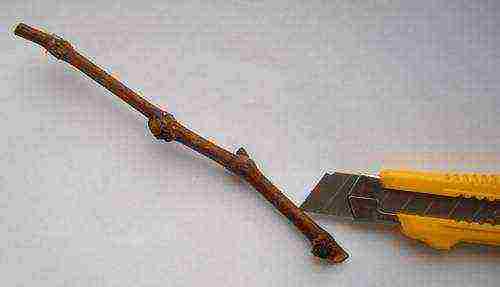
You can apply shallow scratches with any convenient tool, this will greatly facilitate the formation of roots for the cuttings.
So, let's say you decide that you will plant cuttings in the ground only after they give roots. How to germinate cuttings, awaken them and force them to form roots? There are several options here too, but one of them is completely elementary. To germinate cuttings you need:
- Take a liter glass jar or a cut-off plastic bottle, pour boiled water into it in a layer of 4–5 cm.
- Put two tablets of activated carbon into the water to prevent and disinfect water.
- Cover the cuttings with the top cut with garden pitch or plasticine.
- Place the cuttings in the jar.
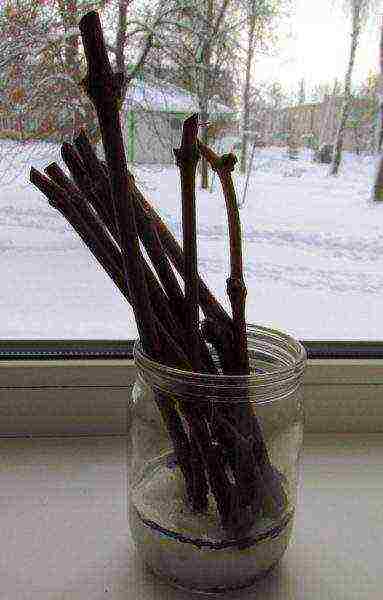
During germination, the water level must be kept constant.
- Put the jar on the battery so that the temperature of the future roots is higher than that of the tops of the cuttings; the temperature should be adjusted with supports for the jar, optimally - from 25 to 30 ° C.
- Constantly monitor the water level: it should almost not fluctuate, it is at the air / water border that roots should appear;
- The water should be changed for the first few days.
- After two weeks, you should wait for the awakening of the kidneys, and another ten days later - for the appearance of white roots.
- As soon as the roots reach a length of 2.5–3 cm, the process must be stopped, the cuttings must be removed from the water and planted in the ground.
A slightly more complicated option is to use scalded coniferous sawdust instead of water. They are also poured in a layer of 4–5 cm, moistened with water, cuttings are placed on them and the same amount of sawdust is added. Sawdust is sometimes replaced with ordinary cotton wool. The option in which the cuttings wrapped in a wet rag are tightly tied in a plastic bag, leaving only the upper kidney outside, apparently, is not worth recommending: in the bag, both souring of water and breaking of the emerging roots are possible.
Video: germinating grape cuttings in water
Planting grape cuttings at home in cups or pots
So, in a container with soil, you can plant both cuttings that have already given roots, and simply soaked cuttings. There is a slight difference in planting technique and soil selection.
Planting germinated cuttings
If we plant cuttings with roots, it means that they already have very small green leaves. If three weeks have passed, there are leaves, but there are no roots yet, this does not mean that everything is lost: for some grape varieties this situation is normal, and you have to wait a little longer, freshening the water or replacing sawdust.Cuttings that have taken root can be planted in pots or large glasses.
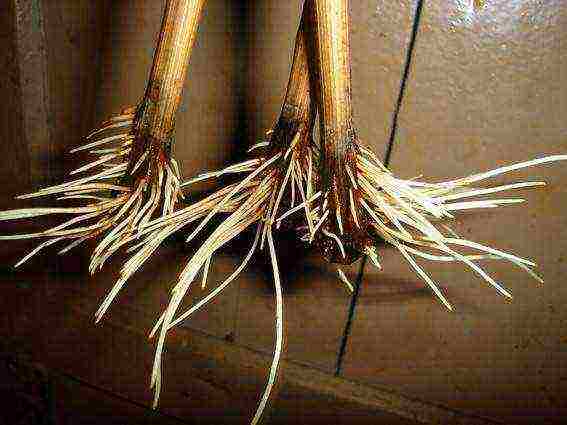
The optimal length of the roots is from 2 to 4 cm, but when planting them, you must try not to break off
To grow grape seedlings from cuttings, it is convenient to use large paper cups or one and a half liter plastic bottles, cutting off their tapering top and making several holes in the bottom to drain excess water with a hot nail. At the bottom of any vessel, it is imperative to lay 3-4 cm of drainage from fine pebbles or coarse sand. Soil is a mixture of equal amounts of fertile land and river sand.

The cut plastic bottles seem to be specially designed for growing grape seedlings.
One cuttings are planted in each container. It is possible and two at a time, if there are a lot of them, and there is not enough space, but then the worst one will have to be removed: it is possible to grow two seedlings in one bottle, but it will be cramped for them, and then it will be impossible to plant them in open ground without disturbing the root system.
If the stalk had three buds, it must be planted so that one is in the ground, the second is close to the surface, and the upper one is in the air. Two-eyed cuttings are buried almost entirely in the ground: the upper bud should be barely visible from under it.
If the leaves on the handle have already unfolded, then the pot need not be covered, and if they just appeared from the bud, for the first time it is necessary to put a plastic bag on it, creating a greenhouse effect. The temperature during the growth of cuttings does not play a special role: it should be at room temperature, and good light is needed, so the containers should be placed closer to the window. In containers, the soil should be constantly slightly moist, but in no case swampy. The frequency of watering depends on the quality of the soil and the conditions in the apartment. Usually it is necessary to water in small portions every few days, sometimes once a week is enough. Water for irrigation should be slightly warmer than room temperature.
Video: planting cuttings in bottles
Planting cuttings without roots
Most grape varieties root perfectly even without preliminary preparation, but when planting cuttings without roots, you need to monitor the humidity and temperature more closely. With proper observance of the conditions, the rooting of such cuttings is almost one hundred percent.
The requirements for capacity and the presence of a drainage layer are the same as in the case of germinated cuttings, but the soil mixture is prepared looser: in addition to sand and soil, you must take humus, mixing them in equal quantities. Many amateurs do without earth and sand altogether, filling containers with boiled coniferous sawdust.
After planting, the substrate is well watered with a pink solution of potassium permanganate and the stalk is covered with a plastic bag. The best temperature for the formation and growth of roots is from 25 to 30 ° C, but they will germinate at a lower temperature, only in a warm substrate will root formation begin much faster. Do not overheat: if the recommended temperature is exceeded, roots may not form.
Until the roots have formed, it is necessary to water the soil often: about every other day, but without fanaticism. Excess water should drain through the holes into the sump. Many generally water it "from below": they put the pot in a bowl of water for a while, and then take it out of it. After 2-3 weeks, you can slightly tug on the handle: if there is resistance, then the roots have begun to form. From this point on, less water is needed: it is better to let the soil seem dry than clearly wet. Around this time, the leaves begin to bloom. As soon as they unfold, the package covering the handle must be removed, and the "vegetable garden" must be transferred to a bright light.

It is necessary to water the cuttings carefully, excess water is more harmful than its lack
Grape cuttings root easily if done correctly. Mistakes in planting cuttings without roots are more fatal than in the case of germinated cuttings. Here's what they can be:
- if the cuttings are poorly soaked or the temperature in the room is low, roots may appear and the leaves may not bloom. It is urgent to raise the temperature and water the cuttings with warm water;
- if the apartment is very dry, roots may appear, and the eyes may not even wake up and dry out: in this case, nothing can be fixed;
- if you do not furrow the cutting and try to get roots in heavy soil, leaves may open, but the roots will not form, as a result, the cutting will die.
Care of planted cuttings
Caring for planted cuttings at home consists in observing the temperature regime, watering, and organizing additional lighting. As already noted, the soil in the cups should not dry out, but stagnation of water is categorically excluded. However, in addition to soil moisture, air humidity is also of great importance, and in a city apartment during the heating season, as a rule, it is dry.
The simplest way out of the situation is that after removing the plastic bag from the handle, two open jars of water are placed next to the structure: one flush with the pot, the second higher, at the level of the upper kidney.
So that the removal of the package does not shock the plant, it can be taught to be without such a hat gradually, removing the package for a short time over several days, and then for a longer time.
It is best to place the "vegetable garden" by the window and the radiator, but the light in March may not be enough for the good development of the future seedling. At the initial stage of growing, strong light is not required. But after the leaves unfold and the shoot begins to grow, most likely you will have to add a fluorescent lamp or a diode lamp to the sunlight. The best temperature for plant development is from 25 to 28 ° C, but even at slightly lower values, growth will be normal.
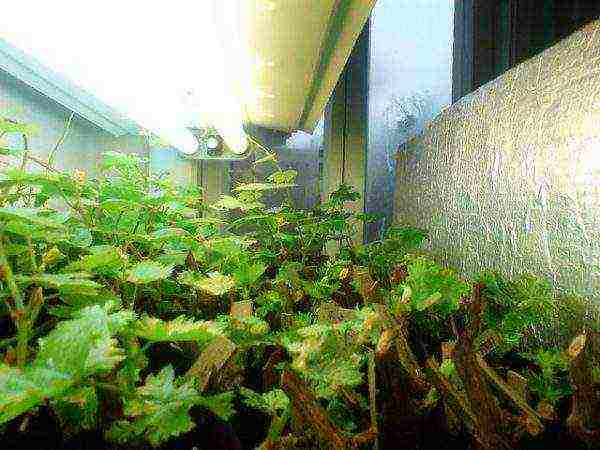
Cold light fluorescent lamp can be positioned directly above the vegetable garden
A month after planting the cuttings, they can be fed with a solution of complex mineral fertilizer according to the instructions, for example, azofoski or special fertilizers for grapes, such as Novofert. In May, it is gradually necessary to accustom future seedlings to fresh air, taking the pots to the balcony. From mid-May, in the absence of obvious cold weather, they should be on the balcony almost around the clock, and at the beginning of summer it is time to land in open ground.
Possible diseases and how to treat them
The quality of seedlings grown from cuttings directly depends on which bushes the cuttings were cut from. If the bushes have been affected by mildew, oidium or gray rot, the cuttings will not take root well and grow. It is from this point of view that it is extremely important to treat cuttings both before winter storage and before planting in pots with chemicals (potassium permanganate, Fundazol, Rovral, etc.). Such treatment allows to destroy spores of infections on the surface and a significant part of diseases developing inside the wood.
During the germination of cuttings in water, it is possible for an infection to enter the water from the outside, which is prevented by changing the water in the jar and adding wood ash or activated carbon to it. Infection is also possible through sawdust used as a substrate. If the infection enters, the tissue of the cuttings dies or the young shoots rot. In severe cases, up to 100% of cuttings may die. Therefore, periodic preventive spraying once a week with Fundazol or Rovral is not an extra operation at all.
Already in the process of growing planting material at home, you can notice problems on young leaves. The signs of the disease are the same as on adult grape bushes.For example, unexpectedly and rather sharply, the leaves may turn yellow. Most likely, this is the most dangerous fungal mildew disease that affects not only leaves, but also young shoots. If the disease has not gone deep, when the first signs appear, the "vegetable garden" should be sprayed with Bordeaux mixture or Ridomil Gold.
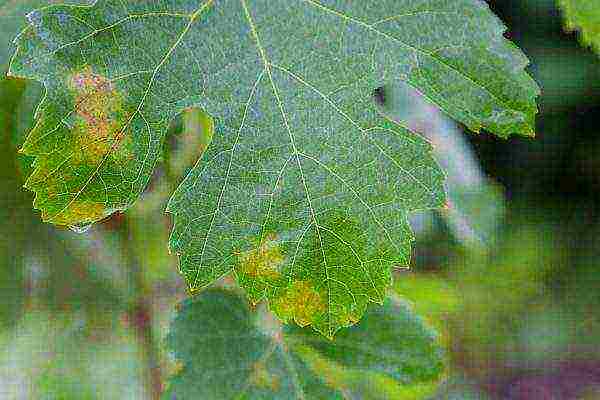
Mildew begins with small yellow spots, but soon covers the entire leaf
In another situation, the leaves may turn black, which also happens unexpectedly, the process progresses quickly. Sometimes this can happen simply from excess moisture or, conversely, from drying out of the soil. In this case, optimizing growing conditions can still save the day. This also happens due to too dense soil. You can try to transplant urgently: if the matter has not gone far and the roots have not died, the transplant can help. If the leaves have turned black from diseases (and this may be the consequences of several infections at once), it will no longer be possible to save the cuttings.
Features of planting cuttings in the spring in a greenhouse or open ground
It is not always convenient to plant a garden in an apartment, often there is simply not enough space for it. In the middle zone, and even more so in the south of our country, the cultivation of grape seedlings from cuttings can often be transferred to a greenhouse. And in the southern regions they even practice planting cuttings directly in open ground.
Planting cuttings in a greenhouse
The period of physiological rest in grapes ends in January, and its cuttings can already be put on germination. However, for growing in a greenhouse, as well as in an apartment, all work begins no earlier than the end of February. All preparatory operations are identical to those performed at home (washing and disinfecting cuttings, cutting them into three-eyed pieces, etc.).
For cultivation in a greenhouse, cuttings are almost always germinated to form roots by placing their ends in a jar of water. Even more often they are planted for the emergence of roots in wet sand directly into the greenhouse, if only the temperature in it has reached values of at least 10–12 ° C. This is the lowest possible temperature for root formation, but heating in the root zone is required for guaranteed success. Therefore, a greenhouse, in which there is no possibility of connecting heating devices at all, in the middle lane or in the north for the early spring cultivation of grape seedlings from cuttings is not suitable.
In case of mass cultivation on racks, sand is poured in a layer of up to 15 cm and cuttings are densely planted in it. In amateur viticulture, we are talking about several copies, so any acceptable capacity can be suitable for sand. If the weather in the region is such that the greenhouse needs to be heated, this should not be done especially for grapes, it will be easier to grow seedlings in an apartment.
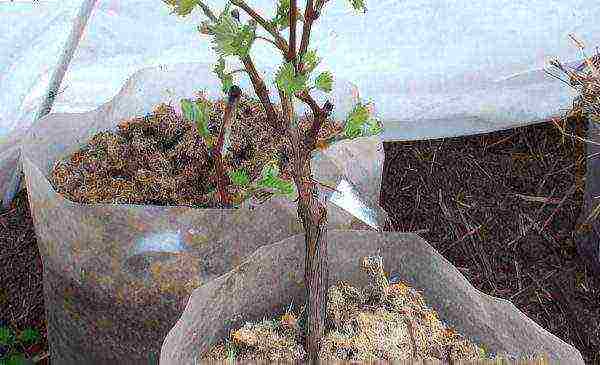
It hardly makes sense to use a greenhouse for growing several seedlings, but as a temporary, "staging" point, it will also work in amateur viticulture.
After planting the cuttings, the sand must be watered with warm water so that it is constantly slightly moistened. The optimum temperature in the greenhouse is about 18 ° C, and the sand in the root zone is about 23 ° C, the air humidity is about 75%. Under such conditions, the roots are well laid, and bud breakup is temporarily delayed.
After 2-3 weeks, leaves and root rudiments should appear at the same time. After another week, the cuttings are carefully transplanted into any containers of sufficient volume (large cups, cut plastic bottles, etc.). It is desirable that by this time the roots of the branch are at least up to 2 cm. The best soil composition for planting containers is sod soil, compost and sand (approximately 40: 40: 20%). In the future, a high temperature is needed, not lower than 25 ° C, and good lighting.
It takes about 2 months from planting in a container to transplanting seedlings to a permanent place. In May, it is necessary to accustom future seedlings to fresh air, opening windows and doors of the greenhouse for a while.At this time, if the shoots have grown from several buds, only one, the most powerful, is left. If it grows too long, then when it reaches a height of half a meter, the top is pinched to it: for planting in open ground, the main shoot should not be long, but strong, let it continue to grow in thickness.
Planting cuttings in open ground
In the southernmost regions of our country, it is possible to plant cuttings directly in open ground. Moreover, this is often done even in the fall, immediately after cutting the cuttings, and at the same time they get good results. When planted in autumn, the cuttings root well and grow back with the onset of warm weather in spring. The stalk is completely buried in the ground in the fall, leaving only one bud on the surface. But for the winter they also spud it, and cover the bed with a film and sprinkle it with a layer of earth. In the spring, the structure is opened, a hole is cut in the film for the escape. The stalk is uncooked only when the grapes are clearly growing and there is a steady heat.
Spring planting of cuttings in open ground is possible when the soil at a depth of 10 cm warms up to 10–12 ° C, in the south this time falls on March. Processing of cuttings before planting is standard, keeping cuttings in a jar of water or wet sawdust is mandatory, at least before the roots begin to grow back.
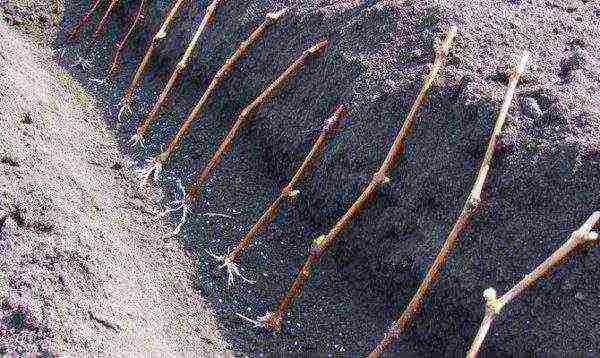
Cuttings are planted in open ground in spring only after they have given roots
Cuttings are planted in well-fertilized soil to a depth of 40 cm: since this is open ground, you do not need to limit yourself to the size of the cuttings, they can have more than 3 buds so that the roots grow powerful immediately. Cuttings are planted with a slight slope, leaving two buds on the surface. If it's still cool, you can temporarily cover them with non-woven materials.
Features of cultivation in different regions
In the case of grapes, the process of growing planting material varies greatly depending on the climatic conditions of the region. If in the southernmost regions they rarely associate with the cultivation of seedlings at home, then in the north it cannot be otherwise.
Districts of the Kuban, including the Krasnodar Territory
In Russia, over half of the grapes are grown in the Krasnodar Territory. The main wine-growing regions are Temryuksky, Anapsky, Krymsky, the cities of Novorossiysk and Gelendzhik. The climate of the Krasnodar Territory is the best suited for viticulture. The weather conditions also differ slightly in other regions, territories and republics of the Kuban region. It is quite warm everywhere here, only the amount of precipitation in certain areas can be very different. The soil is fertile, there is a lot of light, and this makes it possible to get rich harvests of grape berries.
The basic rules for planting in the Kuban do not differ from the usual norms, but seedlings are almost never grown here in a city apartment.
Most often, cuttings are planted directly in open ground, and the "long vine" option is often practiced: in the fall, a piece of vine about one and a half meters long is buried in a large planting hole, twisting it into a spiral and leaving 1-2 buds on the surface. For successful root formation in this option, an irrigation pipe is carried out into the zone of future roots, but a large drainage layer is necessarily arranged.
The soils in many regions of the Kuban are so good that many amateurs do not even dig planting holes, but plant cuttings in the fall “under the ramrod”. This is what they call the technique of making mini-holes with heavy metal scrap. It punches holes 10–12 cm wide and 10–15 cm deeper than the length of the cutting. Fertilized soil is poured onto the bottom of the well (only half a bucket!), Insert a long stalk, tamp the soil, water it well, fill the well so that no voids remain, and wait for a result that is close to 100% success.
Belarus
Previously, Belarus was not considered an area suitable for viticulture, but these times are long gone: now grapes on personal plots are a common thing, although it requires the application of strength and skills. The climate in the country is rather mild, although not very hot; many grape varieties have time to ripen successfully. But the cultivation of seedlings from cuttings is almost always carried out at home, in extreme cases - in a greenhouse, usually heated.
Planting cuttings for cultivation begins here at the usual dates indicated above - at the very end of winter. They use a variety of germination methods, but they do it without fail: almost no one plants cuttings without roots. There is a lot of peat in Belarus, so they try to add it to any soil, and the soil for growing grape seedlings is no exception: the most popular mixture is peat with sand and a small amount of sod land. All other operations are completely similar to those described in the main part of this article.
Moscow suburbs
The climate of the Moscow region is very similar to that of Belarus, but more unpredictable, although this refers to the winter period, when severe frosts alternate with unexpected thaws. Therefore, viticulture is a little more risky here, but this mainly concerns the shelter of adult bushes for the winter and the right choice of grape varieties: it is somewhat limited.
As for the cultivation of seedlings from cuttings, it is carried out in the same way as described above, with a slight shift in timing: cuttings are taken out of storage at the beginning of spring. Their germination for the formation of root rudiments is mandatory, cuttings with roots are planted in a container with soil composed of a mixture of peat and coarse sand. Cuttings are kept in containers a little longer than in Belarus, and are planted in a permanent place closer to mid-June.
Video: grapes from cuttings in the Moscow region
Ural region
Well, who would have thought half a century ago that grapes could be grown in the Urals? Now you can, however, not any varieties, but only the most frost-resistant. You can also grow planting material from cuttings, and this is no more difficult to do than in the middle zone of the European part of Russia. True, the timing is somewhat different here.
Planting cuttings at home is carried out in the same way as in the Moscow region, but they are not planted in June in open ground, but they are grown all summer: first in greenhouses or greenhouses, and from July in the open air. If the growth proceeds powerfully, in the summer the plant is gently transferred into deeper containers (old buckets).
By autumn, planting holes are dug and before the onset of frost (and often already in September) grown seedlings are deeply planted in them, if they already have at least two well-ripened buds. When planting, only one bud is left on the surface, and it is spud and well covered for the winter.
Reviews
For planting grapes on the site, the easiest way, of course, is to buy a ready-made seedling. Sometimes it turns out not more expensive than going all the way from cutting to seedling in a city apartment. But self-cultivation is not only work, but also a great pleasure, especially in case of success. Therefore, most amateurs try to grow grape seedlings from cuttings themselves, and although it is not easy to do this, it is quite possible.
Graduated from the Chemistry Department of Moscow State University in 1981. Candidate of Chemical Sciences, Associate Professor.
Fruitful grapes are propagated vegetatively - by cuttings, layering or grafting. Seeds are sown for breeding purposes only. Amateur gardeners successfully practice spring rooting of grape cuttings at home.
What is a stalk (chubuk) of grapes
A stalk is a section of a stem with several buds.

Grape bushes will grow from these cuttings.
For reproduction at home, take lignified twigs from a matured (brown) vine. They are called cuttings or chubuki.
Benefits of grafting
Breeding grapes with cuttings is a simple procedure available to any winegrower, even a beginner. This method has many advantages.:
- Availability of planting material.
- The ability to quickly get a large number of seedlings.
- The cuttings are compact, at rest; they are easy to store, transport, mail.
- Planting material is very easy to process against diseases and pests.
- The cost of cuttings is significantly lower than that of seedlings.
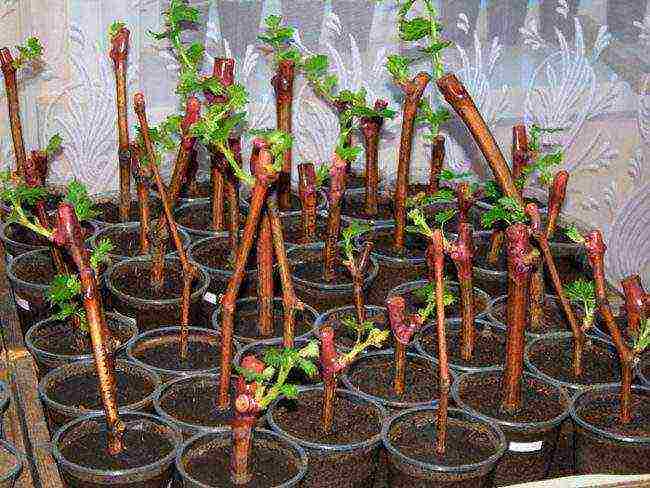
Cutting is the most common method for propagating grapes.
Lignified cuttings can be planted directly in open ground (in spring or autumn), but home rooting is very often used (in late winter or spring).
Pros of a home option
- compact organization of space;
- the ability to control the process of rooting and development;
- removal of negative weather factors;
- a significant run in time, allowing you to build up strong bushes for planting in the current season.

When the snow melts outside the window, good-quality seedlings will already form from the cuttings.
Growing grapes from cuttings at home makes it possible to get full-fledged seedlings in the regions of sheltering viticulture (in the suburbs, in Siberia, in the Urals), even on the northern borders of this zone.
Procurement of planting material
For winter-spring germination, cuttings are taken from ripe (lignified, crackling when bent, brown) annual vine... They are harvested during the autumn pruning of grape bushes (the approximate period is in October, before the establishment of negative temperatures, before the soil freezes). In non-covering zones, breeding shanks can be cut in late autumn and winter - from the vine without signs of freezing or drying out.
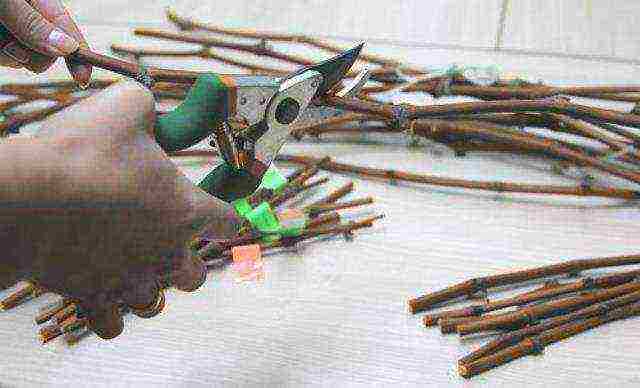
Harvesting cuttings is usually combined with autumn pruning.
It is desirable to obtain material for propagation from the most productive and healthy bushes with typical varietal characteristics. Smooth branches without spots and other defects are considered suitable. If possible, you should choose for grafting middle part those shoots that grew out of central buds of two-year branches.
The optimal cutting thickness is from 0.5 to 1 cm (in varieties with thin vines, this figure may be less).
Too thick, fattening stems have loose wood, it is not recommended to take them.
Shaft length
The length of the shank is not measured in centimeters. It is determined by the number of buds (eyes).
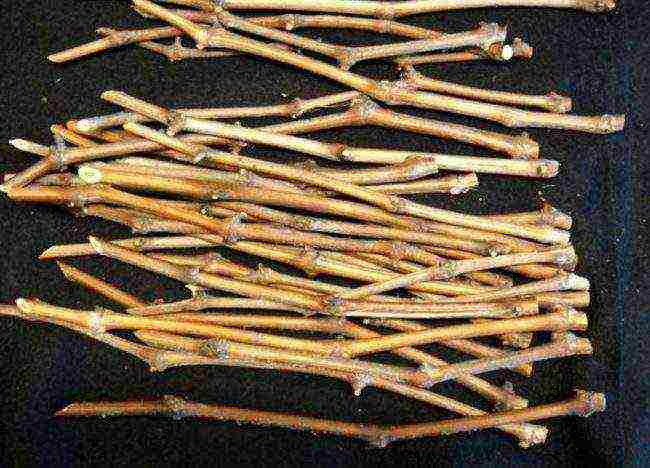
Three-eyed grape cuttings.
Two-eyed and three-eyed cuttings are used more often.although one-eyed and four-eyed ones are also suitable. In the process of cutting, the antennae and stepchildren, the remnants of the foliage, are removed (cut off) from the branches. Sometimes long vines are stored in winter (50-100-170 cm), and cut them before rooting.
The upper cut is made straight, at a height of 20–40 mm above the upper kidney. The lower cut is performed obliquely - under the lower kidney, slightly stepping down from it (it will be updated before planting). It can be difficult for a beginner winegrower to determine on a cut vine - where is the top and where is the bottom.

Slices on a grape cuttings.
Straight and oblique cuts, made directly near the growing bush, later help to understand this issue.... (The photo shows that the pointed tip of the bud looks slightly upward, but the antennae are often directed downward. A small scar is visible under the bud: this is a trace from a fallen leaf petiole.)
The shawls are tied in bunches, tied in two places. Tags with the names of the varieties are immediately attached. Further, the bundles need to be stored for several months. They are pre-processed.
Processing before storage (step by step)
Cuttings:
- soaked in water (preferably rain) for 12 hours (received by shipment, dried up - for 24 hours); laid horizontally so that the water covers them completely, in a small layer;
- disinfect: immersed for 15 seconds in a solution of ferrous sulfate (300 g per 10 l of water) or copper sulfate (400 g per 10 l); either sprayed with one of these drugs; after treatment with iron vitriol, the vine may then turn black - this is normal;
- dry a couple of hours on paper or fabric;
- some gardeners wax the tips (cuts) - dipped in paraffin wax (wax) melted in a water bath and slightly cooled (until a film appears on top);
- put in storage as soon as possible, and before that they are wrapped in a plastic bag or cling film.
The shanks prepared in this way are usually preserved normally.
Storing cuttings before planting
The ideal conditions for preservation are considered to be 80–95% humidity and a temperature of +1 +4 degrees (not higher than +8).
Planting material is kept in a cellar (underground, basement) or in a refrigerator, as well as outdoors - in a snowdrift or in a trench.
Snowdrift

A snowdrift with a thickness of 20 cm or more protects the cuttings from frost, the main thing is not to let it thaw.
In areas with a stable snow cover, cuttings are conveniently stored in a snowdrift, at a depth of at least 50 cm. In loose snow - the optimum temperature and humidity.
Before snowfalls, the cut vine can be wrapped in wet burlap and kept at first just in the garden on the ground, and with the arrival of frost - in a cellar or other room with low positive temperatures. Chubuki are laid in the snow "naked" or pre-packed (in sugar bags, in cut plastic bottles).
Trench
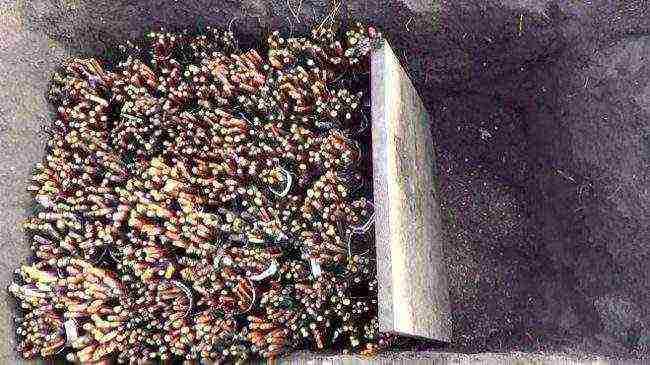
The cuttings can simply be placed in the pit and covered with earth.
- Dig a hole or trench deep in the garden 50-100 cm.
- In it, bundles without packaging are installed vertically on a layer of slightly wet sand, covered with the same sand from above, then they throw the earth to the upper edges of the pit and with a mound on top, cover with a film; overlap with slate or boards is also used.
- Sometimes they simply pack the vine in a sugar bag (or cut plastic bottles) and bury it in the ground to a depth of half a meter. The disadvantage of this method is that it will be difficult to get the shanks until mid-spring.
Some growers combine a shallow trench and (top) a shallow snowdrift... The pit is not covered with earth, a cover is installed on it. With this option, planting material is easy to take at the right time.
In the cellar

When stored in a cellar, the cuttings are placed in a box of sand.
There are several accommodation options.
- The shanks are placed vertically, placing the lower end:
- in potatoes,
- in a small layer of moss,
- in slightly moistened sand (deepening by 5 cm);
- into a bucket of water (water layer only 3-5 cm).
- The whole cuttings are buried in slightly moistened sawdust or sand (with an admixture of charcoal dust).
In the refrigerator or cellar
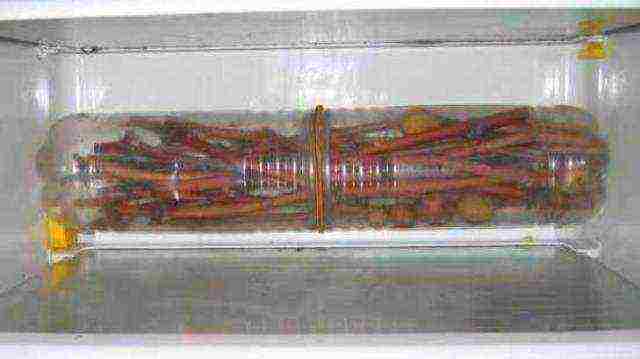
If the cuttings are few, they can be refrigerated.
Use packaging.
- Chubuki are simply put in a plastic bag (garbage bag) or in a sugar bag. The package is lowered into the cellar or placed in the refrigerator (on the door or in the vegetable compartment). Sometimes the vines are pre-wrapped (especially the lower cut) in a slightly damp newspaper. The bag is not tightly tied. At the beginning of January, newspapers are opened once for airing and humidifying.
- Each stalk is wrapped in plastic wrap.
- The bundle is placed in a package of two cut polyethylene bottles. The joint is wrapped with tape. Ventilate 1-2 times during the winter.
There is also such a method of storage: the cuttings are kept suspended in a deep well (above the water).
Timing of awakening (when do grape shanks start to sprout?)
Experienced growers are advised to start this work in February (usually in the second half of the month) or early March.
Those who are accustomed to checking the lunar calendar avoid starting rooting in the barren sign of Aquarius. The development of callus and roots is activated during the waning moon. Sometimes nodules of callus and roots are formed during storage; they need to be protected.
Processing before rooting
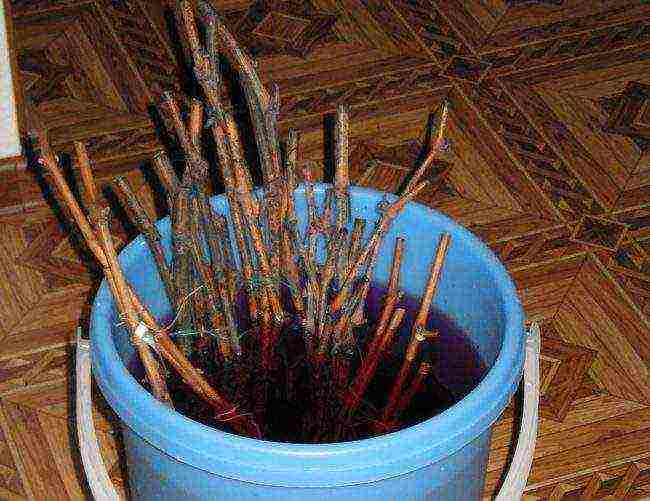
Disinfection of cuttings in a solution of potassium permanganate.
Cuttings are taken out of storage and washed with a solution of potassium permanganate (medium strength), if there are traces of mold. It is important to correctly assess the condition of the planting material, reject the bad one, and prepare the normal one for germination.
Safety check
- Examine the bark: healthy - without wrinkles and blackening.
- Make a cross-section of the stem. A thin layer of cambium under the bark and all wood should be a light green hue. But the brown, black, white color is evidence of death.
- In several branches, the lower buds are incised. Living eyes are bright green inside.
- When pressed with a knife near the cut, a little moisture is normally released from the wood. If there is too much or not at all, the rooting rate will be low.
Soak
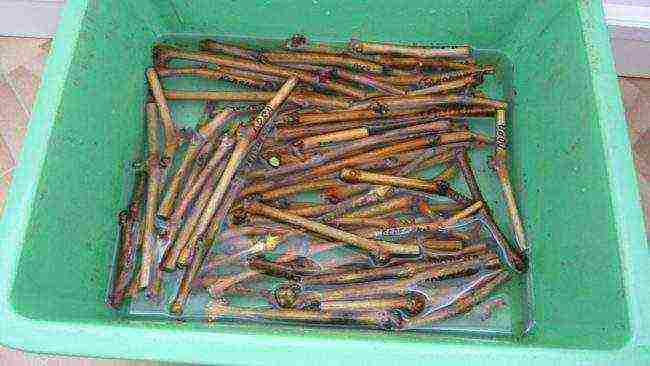
After inspection, the cuttings are placed in a container with melt water for 1-2 days.
- Not only overdried, but also normal cuttings must be soaked before germination.
- They are placed entirely in a small layer of water. (better thawed, snowy) for a period from 12 hours to two days.
- Indoor temperature - about +20 degrees.
- The water is changed every 12 hours.
- Sometimes a little honey is added to it (1 tablespoon per 10 liters of water).
Pruning
Long vines are cut into cuttings with 2-3 eyes.
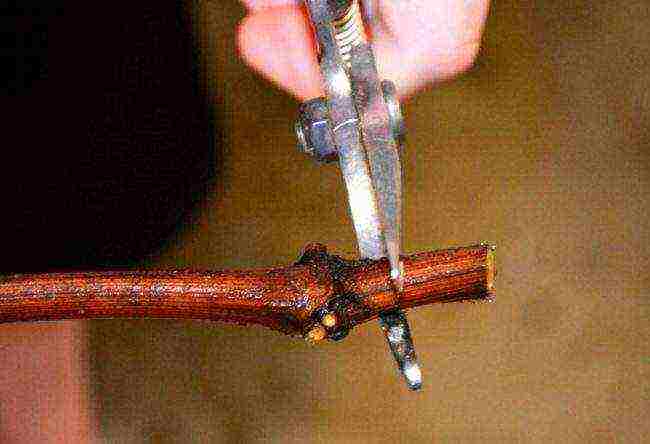
Pruning the grape cuttings under the lower bud.
The shanks, cut from the fall, update the bottom cuts... They are made directly under the lower nodes - obliquely or on a wedge. They work with a sharp knife, without squeezing the tissues. The cut branches are immediately placed in a container with a small layer of water at the bottom.
Some growers remove the lower bud, but there is little need for this.
Waxing (desirable but not required)
The upper sections (height above the kidney 2–4 cm) are not renewed. They are dipped in liquid paraffin (or wax) melted in a water bath and cooled.
Furrowing

Furrowing provokes root development.
Roots are best formed in places where callus is inflated on wound surfaces.
This phenomenon can be provoked. In the lower part of the shanks, several longitudinal grooves are scratched with a knife, deepening to the cambium or wood.
The length of the wounds is approximately 3-6 cm.
Stimulant treatment

Soaking cuttings in a solution of a root stimulator.
The lower part of the cuttings (the lower node and part of the lower internode) is dusted with Kornevin or soaked in one of the liquid root stimulants (solution Heteroauxin, Zircon, Potassium Humate, HB-101 and others - according to the instructions).

A rooting stimulant is available at every gardening store.
The stalk is now ready for rooting. You can do without preliminary work, but they are all aimed at maximum success.
What is grape pickling
Kilchevanie is the creation of a temperature difference in the upper and lower parts of the cutting: heat from below and coolness from above. With kilchevka, the chances of rooting increase.
An important problem in the germination of grapes is the awakening of the buds before the roots grow. Often, the stalk throws out greens, is depleted and dies, not having time to take root. Kilchevanie helps to overcome this problem. In practice, at home, it is carried out in different ways.
- Heated from below (from +20 to + 28 degrees) Produced by placing containers with cuttings on a battery or in a specially designed wagon with bottom heating. The temperature in the zone of the upper kidneys should be much lower - ideally +5 +10 degrees (in reality, at least not higher than +18). To create such contrasting conditions, the kilcher is placed in a cool room. If they dispense with a kilcher, keeping the containers on the battery, then they often open the window, and also construct a protective curtain-screen between the cool window and the warm air of the room.
- Very effective upside down fishingwhen the seedlings are placed vertically "upside down", a moistened material is placed on top, covered with a heated lid.In the case of such a disturbed orientation, the kidneys do not wake up for a long time; roots are formed faster.
Pre-germination of cuttings
Before planting in a container with soil, cuttings sometimes first germinate - until the appearance of callus and small roots (from 2 to 10 mm). The process takes about 3 weeks in a well-lit place (no direct sunlight). Germination can be combined with kilchevaya or carried out independently. There are various options.
- Cuttings are placed in a container with water poured in a small layer - only 2-5 cm... The vessel is placed in a bag, which is tied above the neck. The ends of the cuttings with buds stick out from above. High humidity occurs in the container. Water can be replaced with a small layer of moistened material: cotton wool and gauze, hydrogel, sphagnum moss, coconut substrate, steamed sawdust, cut foam rubber.
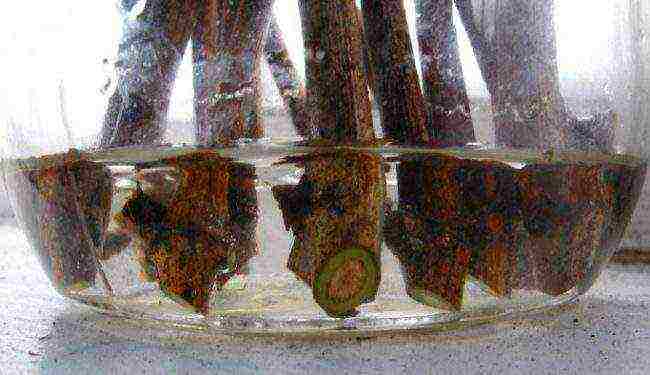
Water must be topped up on time and changed every 4–5 days.
- The lower part of the shanks is wrapped in a damp cloth, then in polyethylene... They are placed horizontally on the windowsill - with their “feet” above the radiator, the tops against the window glass.

After 10-12 days it is necessary to unfold the packaging and moisten the rags.
The substrate and fabric are regularly moistened, the appearance of roots is monitored. They should not be allowed to outgrow. A length of 2 mm is sufficient for transplanting into soil pots. They are installed on a light, warm windowsill.

The cuttings have given roots and are ready for planting in containers with soil.
Containers and soil
For growing seedlings of grapes with a closed root system, plastic cups, cut plastic bottles, nurseries are suitable.
The volume of the pot is from 0.5 to 1 liter (a little more is possible)... Drainage holes are required.
The soil mixture is selected light: sod land, compost, sand in equal proportions. The addition of peat is possible, but not sour.
Method of planting cuttings without prior germination
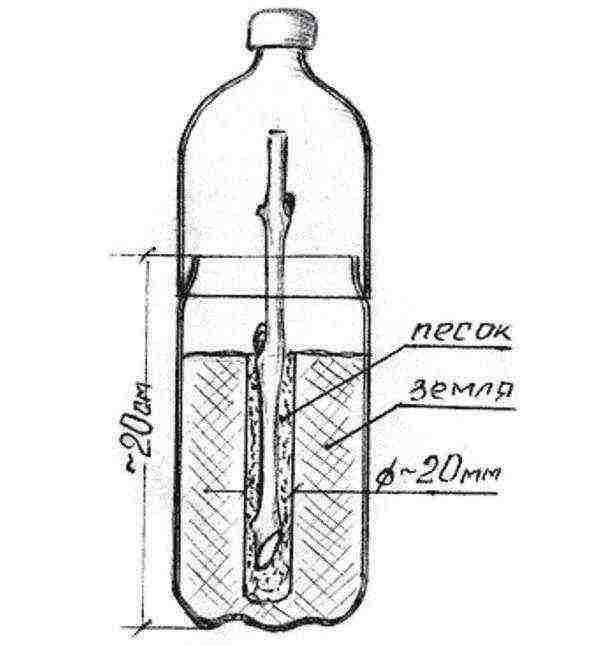
The scheme of germination of the cuttings in a plastic bottle.
- Wet soil is poured into a bottle cut at a height of 20 cm (with drainage holes at the bottom).
- In the center, a hole is made to the very bottom with a diameter of 2 cm, a little sand is poured into it, then a handle is installed, and the remaining space of the hole is filled with sand. It turns out that the grapes are isolated from the soil with a thin layer of sand - this will prevent rotting.
- From above, the container is covered with a "lid" from the cut off top of the bottle, creating greenhouse conditions, high humidity.
- The structure is installed on a pallet, which is fixed to the battery near the window. A plastic wrap curtain will help isolate the cool windowsill from the room, frequent ventilation will lower the temperature on the window.
- When the overgrown roots become visible through the cups, the seedlings are rearranged on the windowsill, the cooling is stopped.
- The growing green shoots are gradually hardened, periodically removing the caps for airing. Then the upper part ("greenhouse") is removed altogether.

The cuttings are 45 days old, the kidney burst - rooting was successful. Now we grow the seedling before planting it on the street.
Landing in the ground
The grown seedlings are hardened on the balcony, window of a garden house or in a greenhouse at a temperature not lower than +10 degrees, avoiding freezing (negative temperatures). They are transplanted into the ground in May or June (according to the weather), covered with agrofibre from the scorching sun and temperature changes (for 2-3 weeks).
